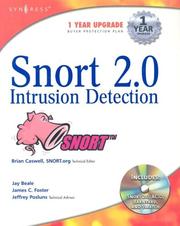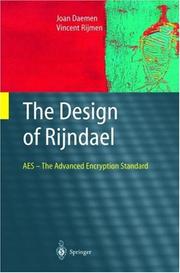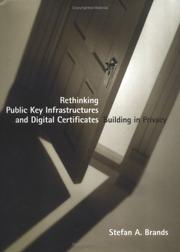| Listing 1 - 10 of 11 | << page >> |
Sort by
|

ISBN: 1931836744 9786611056094 128105609X 0080481000 1932266747 9781932266740 9781931836746 6611056092 9780080481005 Year: 2003 Publisher: Rockland : Oxford : Syngress ; Elsevier Science,
Abstract | Keywords | Export | Availability | Bookmark
 Loading...
Loading...Choose an application
- Reference Manager
- EndNote
- RefWorks (Direct export to RefWorks)
The incredible low maintenance costs of Snort combined with its powerful security features make it one of the fastest growing IDSs within corporate IT departments. Snort 2.0 Intrusion Detection is the first book dealing with the Snort IDS and is written by a member of Snort.org. Readers will receive valuable insight to the code base of Snort and in-depth tutorials of complex installation, configuration, and troubleshooting scenarios. The primary reader will be an individual who has a working knowledge of the TCP/IP protocol, expertise in some arena of IT infrastructure, and is
681.3*D46 --- 681.3*D46 Security and protection: access controls; authentication; cryptographic controls; information flow controls; security kernels; verification (Operating systems) --- Security and protection: access controls; authentication; cryptographic controls; information flow controls; security kernels; verification (Operating systems) --- Contains audio-visual material --- Computer networks --- Computer security. --- Computer privacy --- Computer system security --- Computer systems --- Computers --- Cyber security --- Cybersecurity --- Electronic digital computers --- Protection of computer systems --- Security of computer systems --- Data protection --- Security systems --- Hacking --- Computer network security --- Network security, Computer --- Security of computer networks --- Computer security --- Security measures. --- Protection --- Security measures

ISBN: 1931836043 9786611052645 1281052647 0080480993 9781931836043 1932266844 9781932266849 Year: 2004 Publisher: Rockland, MA : SyngressPub,
Abstract | Keywords | Export | Availability | Bookmark
 Loading...
Loading...Choose an application
- Reference Manager
- EndNote
- RefWorks (Direct export to RefWorks)
Called ""the leader in the Snort IDS book arms race"" by Richard Bejtlich, top Amazon reviewer, this brand-new edition of the best-selling Snort book covers all the latest features of a major upgrade to the product and includes a bonus DVD with Snort 2.1 and other utilities.Written by the same lead engineers of the Snort Development team, this will be the first book available on the major upgrade from Snort 2 to Snort 2.1 (in this community, major upgrades are noted by .x and not by full number upgrades as in 2.0 to 3.0). Readers will be given invaluable insight into the code base of S
681.3*D46 --- 681.3*D46 Security and protection: access controls; authentication; cryptographic controls; information flow controls; security kernels; verification (Operating systems) --- Security and protection: access controls; authentication; cryptographic controls; information flow controls; security kernels; verification (Operating systems) --- Information Technology --- General and Others --- Computer networks --- Computer security. --- Computer privacy --- Computer system security --- Computer systems --- Computers --- Cyber security --- Cybersecurity --- Electronic digital computers --- Protection of computer systems --- Security of computer systems --- Data protection --- Security systems --- Hacking --- Computer network security --- Network security, Computer --- Security of computer networks --- Computer security --- Security measures. --- Protection --- Security measures

ISBN: 1580533248 9781580533249 1580533701 9781580533706 9781580533706 1580533701 Year: 2003 Publisher: Boston : [Piscataqay, New Jersey] : Artech House, IEEE Xplore,
Abstract | Keywords | Export | Availability | Bookmark
 Loading...
Loading...Choose an application
- Reference Manager
- EndNote
- RefWorks (Direct export to RefWorks)
Role-based access control (RBAC) is a security mechanism that can greatly lower the cost and complexity of security administration for large networked applications. RBAC simplifies security administration by using roles, hierarchies, and constraints to organize privileges. This book explains these components of RBAC, as well as how to support and administer RBAC in a networked environment and how to integrate it with existing infrastructure.
Computers --- Computer security. --- Computer networks --- Computer privacy --- Computer system security --- Computer systems --- Cyber security --- Cybersecurity --- Electronic digital computers --- Protection of computer systems --- Security of computer systems --- Data protection --- Security systems --- Hacking --- Computer security --- Access control. --- Protection --- Security measures --- 005.8 --- 681.3 *C2 --- 681.3*D46 --- 681.3*D46 Security and protection: access controls; authentication; cryptographic controls; information flow controls; security kernels; verification (Operating systems) --- Security and protection: access controls; authentication; cryptographic controls; information flow controls; security kernels; verification (Operating systems) --- 681.3 *C2 Computer communication networks: data communications; OSI; security and protection --- Computer communication networks: data communications; OSI; security and protection --- Access control --- Data sovereignty --- Computers - Access control. --- Computer networks - Access control.
Book
ISBN: 9780273793366 9780133370430 Year: 2014 Publisher: Harlow Pearson
Abstract | Keywords | Export | Availability | Bookmark
 Loading...
Loading...Choose an application
- Reference Manager
- EndNote
- RefWorks (Direct export to RefWorks)
Computer architecture. Operating systems --- Computer networks --- Computer security. --- 681.3 *C2 --- 681.3*D46 --- 681.3*D46 Security and protection: access controls; authentication; cryptographic controls; information flow controls; security kernels; verification (Operating systems) --- Security and protection: access controls; authentication; cryptographic controls; information flow controls; security kernels; verification (Operating systems) --- 681.3 *C2 Computer communication networks: data communications; OSI; security and protection --- Computer communication networks: data communications; OSI; security and protection --- Computer privacy --- Computer system security --- Computer systems --- Computers --- Cyber security --- Cybersecurity --- Electronic digital computers --- Protection of computer systems --- Security of computer systems --- Data protection --- Security systems --- Hacking --- Computer network security --- Network security, Computer --- Security of computer networks --- Computer security --- Security measures --- Protection

ISBN: 0585000484 9780585000480 0814479960 Year: 1999 Publisher: New York : AMACOM,
Abstract | Keywords | Export | Availability | Bookmark
 Loading...
Loading...Choose an application
- Reference Manager
- EndNote
- RefWorks (Direct export to RefWorks)
Business enterprises --- Computer security. --- Electronic mail systems --- Computer security --- Management Theory --- Management --- Business & Economics --- E-mail systems --- Electronic message systems --- Email systems --- Data transmission systems --- Telematics --- Voice mail systems --- Computer privacy --- Computer system security --- Computer systems --- Computers --- Cyber security --- Cybersecurity --- Electronic digital computers --- Protection of computer systems --- Security of computer systems --- Data protection --- Security systems --- Hacking --- Computer networks --- Security measures. --- Security measures --- Protection --- 681.3 *C2 --- 681.3*D46 --- Business organizations --- Businesses --- Companies --- Enterprises --- Firms --- Organizations, Business --- Business --- 681.3*D46 Security and protection: access controls; authentication; cryptographic controls; information flow controls; security kernels; verification (Operating systems) --- Security and protection: access controls; authentication; cryptographic controls; information flow controls; security kernels; verification (Operating systems) --- 681.3 *C2 Computer communication networks: data communications; OSI; security and protection --- Computer communication networks: data communications; OSI; security and protection --- Computer networks&delete&

ISBN: 1580532276 9781580532273 0890064474 Year: 1999 Publisher: [Place of publication not identified] Artech House Incorporated
Abstract | Keywords | Export | Availability | Bookmark
 Loading...
Loading...Choose an application
- Reference Manager
- EndNote
- RefWorks (Direct export to RefWorks)
Intranets (Computer networks) --- Extranets (Computer networks) --- Computer networks --- Telecommunications --- Electrical & Computer Engineering --- Engineering & Applied Sciences --- Communication systems, Computer --- Computer communication systems --- Data networks, Computer --- ECNs (Electronic communication networks) --- Electronic communication networks --- Networks, Computer --- Teleprocessing networks --- Data transmission systems --- Digital communications --- Electronic systems --- Information networks --- Telecommunication --- Cyberinfrastructure --- Electronic data processing --- Network computers --- Virtual private networks (Computer networks) --- VPNs (Computer networks) --- Business enterprises --- Wide area networks (Computer networks) --- Internal internets (Computer networks) --- Security measures --- Distributed processing --- 681.3*D46 --- Computer network security --- Network security, Computer --- Security of computer networks --- Computer security --- 681.3*D46 Security and protection: access controls; authentication; cryptographic controls; information flow controls; security kernels; verification (Operating systems) --- Security and protection: access controls; authentication; cryptographic controls; information flow controls; security kernels; verification (Operating systems) --- Computer architecture. Operating systems

ISBN: 3540425802 3642076467 3662047225 9783540425809 Year: 2002 Publisher: Berlin ; Springer
Abstract | Keywords | Export | Availability | Bookmark
 Loading...
Loading...Choose an application
- Reference Manager
- EndNote
- RefWorks (Direct export to RefWorks)
In October 2000, the US National Institute of Standards and Technology selected the block cipher Rijndael as the Advanced Encryption Standard (AES). AES is expected to gradually replace the present Data Encryption Standard (DES) as the most widely applied data encryption technology. This book by the designers of the block cipher presents Rijndael from scratch. The underlying mathematics and the wide trail strategy as the basic design idea are explained in detail and the basics of differential and linear cryptanalysis are reworked. Subsequent chapters review all known attacks against the Rijndael structure and deal with implementation and optimization issues. Finally, other ciphers related to Rijndael are presented. This volume is THE authoritative guide to the Rijndael algorithm and AES. Professionals, researchers, and students active or interested in data encryption will find it a valuable source of information and reference. (flaptekst)
Mathematical control systems --- Programming --- Computer science --- Computer security --- Data encryption (Computer science) --- Passwords --- 681.3*E3 --- 681.3*C2 --- 681.3*D46 --- 681.3*K65 --- AES --- Computerbeveiliging --- Data encryptie --- Rijndael --- Data encoding (Computer science) --- Encryption of data (Computer science) --- Cryptography --- Computer privacy --- Computer system security --- Computer systems --- Computers --- Electronic digital computers --- Security of computer systems --- Data protection --- Security systems --- Hacking --- Passwords. --- Data encryption: data encryption standard; DES; public key cryptosystems --- Computer communication networks: data communications; OSI; security and protection --- Security and protection: access controls; authentication; cryptographic controls; information flow controls; security kernels; verification (Operating systems) --- Security and protection: authentication; insurance; invasive software (e.g. viruses, worms, Trojan horses); physical security; unauthorized access (e.g. hacking, phreaking) --- Security measures --- 681.3*D46 Security and protection: access controls; authentication; cryptographic controls; information flow controls; security kernels; verification (Operating systems) --- 681.3 *C2 Computer communication networks: data communications; OSI; security and protection --- 681.3*E3 Data encryption: data encryption standard; DES; public key cryptosystems --- Data encryption (Computer science). --- Cyber security --- Cybersecurity --- Protection of computer systems --- Protection --- 681.3 *C2 --- Computer security. --- Computer communication systems. --- Algorithms. --- Systems and Data Security. --- Cryptology. --- Computer Communication Networks. --- Algorithm Analysis and Problem Complexity. --- Algorism --- Algebra --- Arithmetic --- Communication systems, Computer --- Computer communication systems --- Data networks, Computer --- ECNs (Electronic communication networks) --- Electronic communication networks --- Networks, Computer --- Teleprocessing networks --- Data transmission systems --- Digital communications --- Electronic systems --- Information networks --- Telecommunication --- Cyberinfrastructure --- Electronic data processing --- Network computers --- Foundations --- Distributed processing --- Computer security - Passwords

ISBN: 9780387308579 0387308571 9786611167462 1281167460 0387381627 Year: 2007 Publisher: Boston, MA : Springer US,
Abstract | Keywords | Export | Availability | Bookmark
 Loading...
Loading...Choose an application
- Reference Manager
- EndNote
- RefWorks (Direct export to RefWorks)
Power analysis attacks allow the extraction of secret information from smart cards. Smart cards are used in many applications including banking, mobile communications, pay TV, and electronic signatures. In all these applications, the security of the smart cards is of crucial importance. Power Analysis Attacks: Revealing the Secrets of Smart Cards is the first comprehensive treatment of power analysis attacks and countermeasures. Based on the principle that the only way to defend against power analysis attacks is to understand them, this book explains how power analysis attacks work. Using many examples, it discusses simple and differential power analysis as well as advanced techniques like template attacks. Furthermore, this volume provides an extensive discussion of countermeasures like shuffling, masking, and DPA-resistant logic styles. By analyzing the pros and cons of the different countermeasures, Power Analysis Attacks: Revealing the Secrets of Smart Cards allows practitioners to decide how to protect smart cards. This book also provides valuable information for graduate and advanced undergraduate students, and researchers working in information security. .
Smart cards --- Cartes à mémoire --- Security measures. --- Sécurité --- Mesures --- 681.3*D46 --- 681.188 --- beveiligingsystemen --- computerbeveiliging --- smart cards --- Security and protection: access controls; authentication; cryptographic controls; information flow controls; security kernels; verification (Operating systems) --- Cryptographic devices. Ciphering, encoding machines. Deciphering, decoding machines --- cryptografische inrichtingen, ontcijferingsmachines --- Smart cards -- Security measures. --- Computer Science --- Electrical Engineering --- Engineering & Applied Sciences --- Electrical & Computer Engineering --- Security measures --- 681.188 Cryptographic devices. Ciphering, encoding machines. Deciphering, decoding machines --- 681.3*D46 Security and protection: access controls; authentication; cryptographic controls; information flow controls; security kernels; verification (Operating systems) --- Cartes à mémoire --- Sécurité --- EPUB-LIV-FT LIVINFOR SPRINGER-B --- Cards, Smart --- Chip cards --- IC cards --- Integrated circuit cards --- Memory cards --- Computer science. --- Computer communication systems. --- Computer security. --- Data structures (Computer science). --- Data encryption (Computer science). --- Computer engineering. --- Electrical engineering. --- Computer Science. --- Systems and Data Security. --- Communications Engineering, Networks. --- Computer Engineering. --- Data Encryption. --- Data Structures, Cryptology and Information Theory. --- Computer Communication Networks. --- Computer storage devices --- Expansion boards (Microcomputers) --- Near-field communication --- Telecommunication. --- Data structures (Computer scienc. --- Cryptology. --- Data Structures and Information Theory. --- Electric communication --- Mass communication --- Telecom --- Telecommunication industry --- Telecommunications --- Communication --- Information theory --- Telecommuting --- Data encoding (Computer science) --- Encryption of data (Computer science) --- Computer security --- Cryptography --- Computer privacy --- Computer system security --- Computer systems --- Computers --- Cyber security --- Cybersecurity --- Electronic digital computers --- Protection of computer systems --- Security of computer systems --- Data protection --- Security systems --- Hacking --- Protection --- Data structures (Computer science) --- Information structures (Computer science) --- Structures, Data (Computer science) --- Structures, Information (Computer science) --- Electronic data processing --- File organization (Computer science) --- Abstract data types (Computer science)
Book
ISBN: 1280637005 9786610637003 0080465161 0750679603 9780080465166 9780750679602 9780750679527 0750679522 Year: 2006 Publisher: Amsterdam ; Boston : Elsevier Newnes,
Abstract | Keywords | Export | Availability | Bookmark
 Loading...
Loading...Choose an application
- Reference Manager
- EndNote
- RefWorks (Direct export to RefWorks)
* Clear, practical tutorial style text with real-world applications * First book on TPM for embedded designers * Provides a sound foundation on the TPM, helping designers take advantage of hardware security based on sound TCG standards* Covers all the TPM basics, discussing in detail the TPM Key Hierarchy and the Trusted Platform Module specification* Presents a methodology to enable designers and developers to successfully integrate the TPM into an embedded design and verify the TPM's operation on a specific platform* Includes an accompanying CD
Computer security. --- Data encryption (Computer science). --- Embedded computer systems. --- Data encryption (Computer science) --- Data encoding (Computer science) --- Encryption of data (Computer science) --- Computer privacy --- Computer system security --- Computer systems --- Computers --- Cyber security --- Cybersecurity --- Electronic digital computers --- Security of computer systems --- Embedded systems (Computer systems) --- Security measures --- Protection of computer systems --- Protection --- Computer security --- Cryptography --- Data protection --- Security systems --- Hacking --- Architecture Analysis and Design Language --- Embedded computer systems --- 6813*C20 --- 681.3*D46 --- 681.3*D47 --- 681.3*E3 --- 681.3*E3 Data encryption: data encryption standard; DES; public key cryptosystems --- Data encryption: data encryption standard; DES; public key cryptosystems --- 681.3*D46 Security and protection: access controls; authentication; cryptographic controls; information flow controls; security kernels; verification (Operating systems) --- Security and protection: access controls; authentication; cryptographic controls; information flow controls; security kernels; verification (Operating systems) --- 681.3*D47 Organization and design: batch processing systems; distributed systems; hierarchical design; interactive systems; real-time systems (Operating systems) --- Organization and design: batch processing systems; distributed systems; hierarchical design; interactive systems; real-time systems (Operating systems) --- Computer-communication networks: general: data communications, open systems interconnection reference model (OSI), security and protection (e.g., firewalls)

ISBN: 0262269139 1423725344 9780262269131 9780262024914 0262024918 Year: 2000 Publisher: Cambridge, Mass. : MIT Press,
Abstract | Keywords | Export | Availability | Bookmark
 Loading...
Loading...Choose an application
- Reference Manager
- EndNote
- RefWorks (Direct export to RefWorks)
Stefan Brands proposes cryptographic building blocks for the design of digital certificates that preserve privacy without sacrificing security.As paper-based communication and transaction mechanisms are replaced by automated ones, traditional forms of security such as photographs and handwritten signatures are becoming outdated. Most security experts believe that digital certificates offer the best technology for safeguarding electronic communications. They are already widely used for authenticating and encrypting email and software, and eventually will be built into any device or piece of software that must be able to communicate securely. There is a serious problem, however, with this unavoidable trend: unless drastic measures are taken, everyone will be forced to communicate via what will be the most pervasive electronic surveillance tool ever built. There will also be abundant opportunity for misuse of digital certificates by hackers, unscrupulous employees, government agencies, financial institutions, insurance companies, and so on.In this book Stefan Brands proposes cryptographic building blocks for the design of digital certificates that preserve privacy without sacrificing security. Such certificates function in much the same way as cinema tickets or subway tokens: anyone can establish their validity and the data they specify, but no more than that. Furthermore, different actions by the same person cannot be linked. Certificate holders have control over what information is disclosed, and to whom. Subsets of the proposed cryptographic building blocks can be used in combination, allowing a cookbook approach to the design of public key infrastructures. Potential applications include electronic cash, electronic postage, digital rights management, pseudonyms for online chat rooms, health care information storage, electronic voting, and even electronic gambling.
Computer networks --- Computer network protocols. --- Data encryption (Computer science) --- Computer security. --- Electrical & Computer Engineering --- Engineering & Applied Sciences --- Telecommunications --- Security measures. --- Computer privacy --- Computer system security --- Computer systems --- Computers --- Cyber security --- Cybersecurity --- Electronic digital computers --- Security of computer systems --- Data encoding (Computer science) --- Encryption of data (Computer science) --- Protocols, Computer network --- Computer network security --- Network security, Computer --- Security of computer networks --- Security measures --- Protection of computer systems --- Protection --- Data protection --- Security systems --- Hacking --- Computer security --- Cryptography --- COMPUTER SCIENCE/General --- Public key infrastructure (Computer security) --- Infrastructure, Public key (Computer security) --- PKI (Computer security) --- Trust hierarchy (Computer security) --- Computer network protocols --- -Data encryption (Computer science) --- 681.3*D46 --- 681.3*D46 Security and protection: access controls; authentication; cryptographic controls; information flow controls; security kernels; verification (Operating systems) --- Security and protection: access controls; authentication; cryptographic controls; information flow controls; security kernels; verification (Operating systems) --- Communication systems, Computer --- Computer communication systems --- Data networks, Computer --- ECNs (Electronic communication networks) --- Electronic communication networks --- Networks, Computer --- Teleprocessing networks --- Data transmission systems --- Digital communications --- Electronic systems --- Information networks --- Telecommunication --- Cyberinfrastructure --- Electronic data processing --- Network computers --- Distributed processing
| Listing 1 - 10 of 11 | << page >> |
Sort by
|

 Search
Search Feedback
Feedback About
About Help
Help News
News